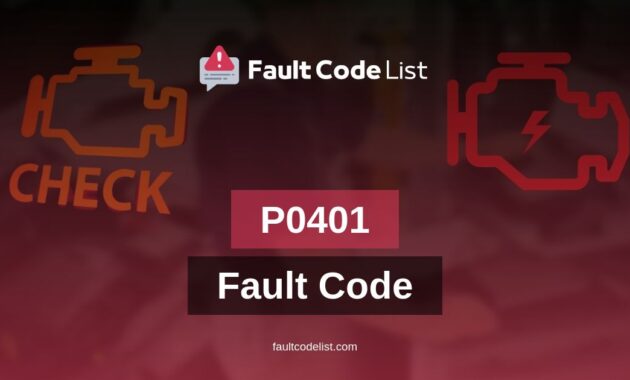You’re driving your car and suddenly the check engine light comes on. You find out from a diagnostic code reader or mechanic that the problem is related to the P0401 fault code. What does this code mean and how can you fix it?
What is the P0401 Fault Code?
The P0401 fault code is a generic OBD-II code that indicates a malfunction in the exhaust gas recirculation (EGR) system. This system is designed to reduce nitrogen oxide (NOx) emissions by recirculating exhaust gases back into the engine, where they are burned again. The EGR system consists of various components, such as the EGR valve, EGR vacuum control solenoid, EGR pressure sensor, and EGR passages, that work together to control the flow of gases.

What Causes the P0401 Fault Code?
There are several common causes of the P0401 fault code:
- A clogged or stuck EGR valve
- A failed EGR vacuum control solenoid
- A failed EGR pressure sensor
- A vacuum hose leak or blockage
- A dirty or carbon-deposited EGR passage
These issues can prevent the EGR system from functioning properly and trigger the check engine light.
What are the Symptoms of the P0401 Fault Code?
The P0401 fault code may cause various symptoms, depending on the severity of the problem:
- The check engine light may turn on, indicating a fault code
- The engine may run rough or misfire, especially at idle
- The engine may hesitate or stall during acceleration
- The fuel economy may decrease
- The exhaust emissions may exceed the legal limits
If the EGR system fails completely, the engine may not start or run at all.
How to Fix the P0401 Fault Code?
In order to fix the P0401 fault code, you need to diagnose the cause of the problem and repair or replace the faulty component(s). Here are some steps you can take:
- Read the code with a diagnostic code reader or scanner
- Inspect the vacuum hoses and connections for leaks or blockages
- Clean the EGR valve and passages with carburetor cleaner or a specialized EGR cleaner
- Test the EGR vacuum control solenoid and replace if failed
- Test the EGR pressure sensor and replace if failed
- Reset the code and test-drive the vehicle to verify if the repair was successful
If you’re not familiar with car repairs or don’t have the necessary tools and skills, it’s recommended to take your car to a qualified mechanic or repair shop.
